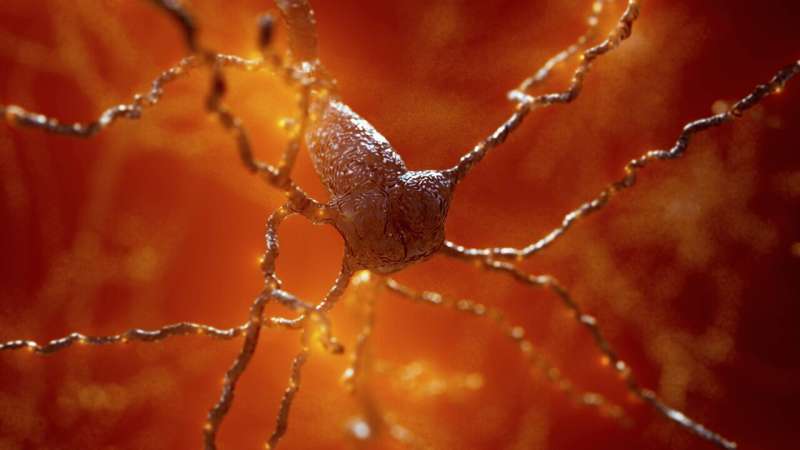This article has been reviewed according to Science X's editorial process and policies. Editors have highlighted the following attributes while ensuring the content's credibility:
fact-checked
peer-reviewed publication
trusted source
proofread
New research challenges conventional picture of Parkinson's disease

Parkinson's disease, the second most common type of progressive dementia after Alzheimer's disease, affects nearly 1 million people in the U.S. and an estimated 10 million individuals worldwide. Each year, close to 90,000 new cases of Parkinson's disease are diagnosed in the U.S.
In a new study, Jeffrey Kordower, director of the ASU-Banner Neurodegenerative Disease Research Center, and his colleagues unveil pivotal insights into the progression of Parkinson's disease, presenting new hope for patients battling the severely debilitating disorder.
The research highlights the role of a critical protein called tau in the early stages of the disease. The results suggest that aggregates of the tau protein may jump-start processes of neuronal damage and death characteristics of the disease.
The findings challenge the conventional view of Parkinson's disease pathology, which typically focuses on the protein alpha-synuclein as the classic diagnostic hallmark of the disease. The new study illustrates how tau pathology could be actively involved in the degeneration of dopamine-producing neurons in the brain, independent of alpha-synuclein. This revelation could shift the focus of Parkinson's disease research, diagnosis, and treatment.
"Currently, a protein called alpha-synuclein is believed to be the main player in Parkinson's disease pathogenesis," says Kordower, who is also a professor with ASU's School of Life Sciences. "This study highlights that misfolded tau may be the first player in causing the cardinal motor symptoms in the disease."
The paper is published in the journal Brain.
Shattering progression
The progression of Parkinson's disease involves distinct stages, and the timeline can vary significantly among individuals. The typical stages of Parkinson's, as outlined by the Parkinson's Foundation, can help patients understand the changes as they occur.
The disease impacts people in different ways, and not everyone will experience all the symptoms or experience them in the same order or intensity. Some may experience the changes over 20 years or more; for others, the disease advances rapidly.
The progression of the disease is influenced by a combination of genetic and environmental factors. Following a diagnosis, many individuals experience a good response to medications such as levodopa, and this optimal time frame can last for many years. Over time, however, modifications to medication are often needed, and symptoms may intensify.
The prevalence of Parkinson's has doubled in the past 25 years, which may be related to population growth, aging, genetic predisposition, lifestyle changes, and environmental pollution.
A fresh perspective
The tau protein accumulates in two regions: the substantia nigra and putamen, both part of the basal ganglia in the brain. The substantia nigra is responsible for the production of dopamine, which is critical for modulating movement, cognitive executive functions, and emotional limbic activity.
The putamen, a component of the dorsal striatum, is involved in movement initiation, selection, and decision-making, as well as learning, memory, language, and emotion. Dysfunction in the putamen can contribute to various disorders, particularly those related to motor function.
A wide range of physical and mental symptoms characterize Parkinson's disease. These include rhythmic tremors, often beginning in a limb, such as a hand or fingers; slowness of movement, which can lead to difficulty in performing simple tasks; muscle stiffness or rigidity; and difficulties with balance.
In addition to these physical symptoms, Parkinson's disease can also cause various mental and emotional changes, including depression and anxiety, sleep disorders, memory difficulties, fatigue, and emotional changes.
Brain traces of disease
The scientists conducted the study using postmortem brain tissue from older adults who had experienced different degrees of motor impairment. The research analyzed brain tissues from individuals with no motor deficits, mild motor deficits with and without Lewy pathology in the nigral region of the brain, and from individuals clinically diagnosed with Parkinson's disease.
Lewy bodies are abnormal aggregates of the protein alpha-synuclein that accumulate in the brain, and they are a hallmark of several neurodegenerative disorders, including Parkinson's and dementia with Lewy bodies.
In the case of Parkinson's, Lewy bodies are primarily found in the substantia nigra, a region of the brain that is crucial for movement control, which leads to characteristic motor symptoms such as rigidity, tremors and bradykinesia (slow movement).
The study focused on a cohort of subjects with mild motor impairments—not pronounced enough to diagnose Parkinson's, but still significant. Dividing these subjects based on the presence or absence of α-synuclein, researchers found that tau pathology was a common denominator.
The researchers observed that the brain tissue associated with minimal motor deficit demonstrated similar accumulations of tau to those with advanced Parkinson's, suggesting that tau's role occurs early in the disease's evolution. These findings open doors to earlier diagnosis and intervention, potentially slowing or altering the disease's progression.
The research also sheds light on parkinsonism, a condition that mimics Parkinson's disease symptoms but is distinct in its underlying mechanisms. The study suggests that tau pathology in the nigrostriatal region of the brain is a shared characteristic, offering a new lens through which to view and treat various forms of Parkinsonism.
The findings also underscore the potential of targeting tau pathology as a therapeutic approach to Parkinson's disease. Because tau aggregation correlates with motor deficits and degeneration of dopamine-producing regions of the brain, interventions aimed at reducing tau accumulation could offer new hope for altering the disease's trajectory.
More information: Yaping Chu et al, Nigrostriatal tau pathology in parkinsonism and Parkinson's disease, Brain (2023). DOI: 10.1093/brain/awad388


















